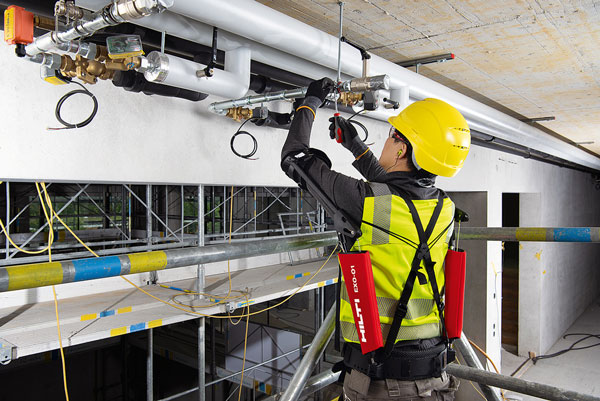Wearable technology is part of everyday life, whether it’s a SmartWatch on the wrist or a mobile device on the belt. Such unobtrusive wizardry has not escaped the minds of inventors and designers seeking to improve the health and safety of construction workers.
Proximity
Observing social distancing has played a key role in allowing worksites to remain open during the COVID-19 pandemic. However, workers can still drift around the site not necessarily aware that they are breaking the two-metre barrier.
The Proximity Trace from Triax Technologies addresses this health and safety issue. It’s based on a small device the company calls Spot-r Clip, about half the size of a mobile phone, which attaches either to a construction helmet or is worn with a lanyard. Not only does the device emit an alarm when distancing between co-workers becomes too close, it can initiate a contact tracing feature to identify individuals who might have been exposed to a confirmed COVID case.
This is not a standalone COVID device. Triax has developed a line-up of real-time safety alerts called Spot-r Suite that can generate site safety alerts, automate worker headcounts and timekeeping on site, and control site access credentials. Detailed reports are generated automatically and sent to a supervisor’s laptop or handheld tablet.
Fatigue
Another headgear technology originates from the land down under. The SmartCap, from the Wenco International Mining Systems division of Hitachi Construction Machinery, is a headband that clips inside a worker’s regular construction helmet. The SmartCap addresses worker fatigue, specifically microsleep events — brief episodes of fatigue-based loss of attention that can affect the safe operation of vehicles and machinery. The concept was developed in collaboration the Cooperative Research Center for Mining based in Brisbane, Aus.
The SmartCap monitors EEG (brain activity) and delivers fatigue alarms through a mobile device carried by the worker. Internet connectivity opens the door to event analysis, which in turn can lead to preventative action plans and solutions. Wenco claims the SmartCaps currently used in rail, mining and construction have led to an 84 per cent reduction in distraction, a 61 per cent reduction in human errors and even a measureable reduction in vehicle fuel consumption.
Noise
Addressing the issue of noise on the worksite, ProAware ear buds and LinkAware headphones from ISOtunes incorporate sound technology that reduces surrounding noise by 25 per cent, thus filtering out harmful sounds, while maintaining situational site awareness such as warning signals and communication from co-workers.
The buds can be connected either by wire or using Bluetooth. Both bud and headphone versions are battery powered, with a life between charges of 10 and 14 hours respectively, and sell for US$130.
Muscle support
After years of expectations and demonstrations, it seems that an exoskeleton assist is finally available at a reasonable cost.
The Hilti EXO-01 is now being offered for delivery at around US$1,600, a far cry from the prohibitively expensive and cumbersome prototypes demonstrated at construction shows over the past five years.
The device weighs less than five pounds and takes only seconds to put on. It sits on the hips, somewhat like a backpack. It’s fully adjustable for each worker’s height and weight, with a fitting range from five-foot, two inches to six-foot, four inches. The amount of lifting aid is also adjustable.
Hilti’s EXO-01 was developed in collaboration with prosthetics and orthotics manufacturer Ottobock specifically to meet the requirements of construction. The device minimizes any restriction of physical movement or range, and only begins to provide support when the worker’s arms are raised above waist level. That’s when fatigue can set in and when skeletal and muscular injuries can develop.
A company spokesperson says the Hilti EXO-01 doesn’t make the worker stronger, but instead makes tools feel lighter, thus reducing the strain on arms and shoulders by as much as 47 per cent when working overhead. Beta tests in the field suggest it takes only one day for workers to feel fully comfortable wearing the device.
John Bleasby is a Coldwater, Ont.-based freelance writer. Send comments and Inside Innovation column ideas to editor@dailycommercialnews.com.





Recent Comments
comments for this post are closed